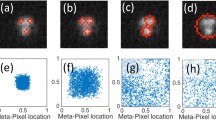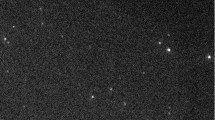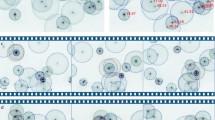Abstract
Determining the positions, shapes and sizes of finite living particles such as bacteria, mitochondria or vesicles is of interest in many biological processes. In fluorescence microscopy, algorithms that can simultaneously localize such particles as a function of time and determine the parameters of their shapes and sizes at the nanometer scale are not yet available. Here we develop two such algorithms based on convolution and correlation image analysis that take into account the position, orientation, shape and size of the object being tracked, and we compare the precision of the two algorithms using computer simulations. We show that the precision of both algorithms strongly depends on the object’s size. In cases where the diameter of the object is larger than about four to five times the beam waist radius, the convolution algorithm gives a better precision than the correlation algorithm (it leads to more precise parameters), while for smaller object diameters, the correlation algorithm gives superior precision. We apply the convolution algorithm to sequences of confocal laser scanning micrographs of immobile Escherichia coli bacteria, and show that the centroid, the front end, the rear end, the left border and the right border of a bacterium can be determined with a signal-to-noise-dependent precision down to ~5 nm.











Similar content being viewed by others
References
Anderson CM, Georgiou GN, Morrison IEG, Stevenson GVW, Cherry RJ (1992) Tracking of cell surface receptors by fluorescence digital imaging microscopy using a charged-coupled device camera. J Cell Sci 101:415-425
Bobroff N (1986) Position measurement with a resolution and noise-limited instrument. Rev Sci Instrum 57:1152-1157
Cheezum MK, Walker WF, Guilford WH (2001) Quantitative comparison of algorithms for tracking single fluorescent particles. Biophys J 81:2378-2388
Gennerich A, Schild D (2000) Fluorescence correlation spectroscopy in small cytosolic compartments depends critically on the diffusion model used. Biophys J 79:3294-3306
Gennerich A, Schild D (2002) Anisotropic diffusion in mitral cell dendrites revealed by fluorescence correlation spectroscopy. Biophys J 83:510-522
Kim SA, Schwille P (2003) Intracellular applications of fluorescence correlation spectroscopy: prospects for neuroscience. Curr Opin Neurobiol 13:583-590
Krichevsky O, Bonnet G (2002) Fluorescence correlation spectroscopy: the technique and its application. Rep Prog Phys 65:251-297
Kues T, Peters P, Kubitscheck U (2001) Visualization and tracking of single protein molecules in the cell nucleus. Biophys J 80:2954-2967
Marquarth DW (1963) An algorithm for least-squares estimation of nonlinear parameters. J Soc Indust Appl Math 11:431-441
Petersen NO, Höddelius PL, Wiseman PW, Seger O, Magnusson KE (1993) Quantitation of membrane receptor distributions by image correlation spectroscopy: concept and application. Biophys J 65:1135-1146
Rigler R, Mets Ü, Widengren J, Kask P (1993) Fluorescence correlation spectroscopy with high count rate and low background: analysis of translational diffusion. Eur Biophys J 22:169-175
Saxton MJ, Jacobson K (1997) Single-particle tracking: applications to membrane dynamics. Annu Rev Biophys Biomol Struct 26:373-399
Schütz GJ, Schindler H, Schmidt T (1997) Single-molecule microscopy on model membranes reveals anomalous diffusion. Biophys J 73:1073-1080
Thompson RE, Larson SR, Webb WW (2002) Precise nanometer localization analysis for individual fluorescent probes. Biophys J 82:2775-2783
Walker WF, Trahey GE (1994) A fundamental limit on the performance of correlation based phase correction and flow estimation techiques. IEEE T Ultrason Ferroelec Freq Cont 41:644-654
Yildiz A, Forkey JN, McKinney SA, Ha T, Goldman YE, Selvin PR (2003) Myosin V walks hand-over-hand: single fluorophore imaging with 1.5-nm localization. Science 300:2061-2065
Yu DF, Fessler JA (2000) Mean and variance of single photon counting with deadtime. Phys Med Biol 45:2043-2056
Author information
Authors and Affiliations
Corresponding author
Appendices
Appendix A
Derivation of Eq. 10 leads to the three intensity contributions of the first cap, the shaft, and the second cap of the model bacterium: \( I^{{{\text{ell1}}}}_{{{\text{obj}}}} (\tilde{x},\tilde{y}) \) , \( I^{{{\text{cyl}}}}_{{{\text{obj}}}} (\tilde{x},\tilde{y}) \) and \( I^{{{\text{ell2}}}}_{{{\text{obj}}}} (\tilde{x},\tilde{y}) \) , respectively,
and
where
Appendix B
Carrying out the numerical optimization procedure for the hemiellipsoidal caps leads to the following parameters for the slices:
whereas the width
of the middle slice of length x C =d x (see Fig. 3b) follows directly from the requirement that the cylinder and slice volume be identical, in other words π d 2 y d x /4=y 2 C d x .
Appendix C
The five intensity distributions describing the the slice model (Eq. 11), are given by
and
where
Appendix D
The slice model can only be preferred if the error introduced by approximating the sausage model by slices is acceptable. The question to be answered here is therefore: how well does the slice model approximate the sausage model?
Let us adopt the sausage model assuming morphologically-realistic E.coli parameters, and then calculate the resulting fluorescence intensity Iobj(x,y) according to Eq. 10 (Fig. 12a). A cross-section at y=32 through its maximum is shown by the continuous curves shown in (b) and (c) of this figure. Then we fit the intensity distribution \( \mathcal{I}_{{{\text{obj}}}} (x,y) \) (Eq. 11 with Eqs.38 and 39) of the corresponding slice model to the calculated intensity distribution of the sausage model. A section through this function at y=32 gives the dashed curve shown in Fig. 12b. Though the maximum amplitude of the sausage object is underestimated by the slice model fit, the front and rear edge of the intensity distribution are almost perfectly fitted (Fig. 12b, dashed versus continuous curve) due to the good approximation of the bacterium’s caps by the stack of slices (Fig. 3c). As the front and rear edge of the intensity distribution are well described by the intensity distribution of the slice model, the resulting length parameter of d=36.018 pixels is in good agreement with the length of d=36 pixels of the underlying sausage model. For a given pixel size of 88 nm, this corresponds to a deviation of 1.6 nm, much smaller than the experimental precision that can be achieved under our conditions (see below).
Intensity distribution of the sausage model and its approximation by the intensity distributions of a slice and a box model, respectively.a Theoretical distribution Iobj(x,y) (Eq. 10, \( x = \tilde{x} \) and \( y = \tilde{y} \)) of the sausage model, calculated with the parameters: d x =25 pixels, d1=d2=5.5 pixels, d y =11 pixels, φ=0 and p0=(49,32). E. coli length: d=36 pixels. b x-section through the intensity distribution of the sausage model shown in (a) (solid line) and through the fitted intensity distribution \( \mathcal{I}_{{{\text{obj}}}} (x,y) \) (Eq. 11 with Eqs. 6, 7, 38 and 39) of the slice model (dashed line) both at y=32. Result of the fit: d x =24.7 pixels, d1=5.66 pixels, d2=5.658 pixels, d y =10.492, x0=49 pixels, y0=32 pixels and φ=0 (χ2=5456.97). These data result in an object length of d=36.018 pixels.c Fitting the intensity distribution of a simple box model (Eq. 11 with d1=d2=0) gave (dashed line): d x =32.886 pixels, d y =10.3 pixels and φ=0 (χ2=15250.22)
The negligible error of the slice model approximation suggests that a simple box model (a slice model with just one slice) might be sufficient to approximate the sausage model. However, assuming a slice model with d1=d2=0 (just one box without the hemiellipsoidal caps attached to it, Fig. 3), a clear deviation between the distributions is seen at the edges (Fig. 12c). A box model is thus too coarse for assessing the bacterium’s edges. This is also reflected in the larger deviation between the resulting width of d y =10.492 of the box model and the exact width of d y =11 pixels of the sausage model. For the same pixel size, this would correspond to a bias of ~51 nm. The reason for this discrepancy is obviously the mismatch between the rectangular cross-sections of the slice model and the circular cross-sections of the sausage model. If the slice model is used instead for determining the relative displacements of the left and right borders of the sausage model, the bias becomes much smaller: increasing the width d y of the sausage model from 11 pixels to 11.1 pixels (all other parameters kept unchanged, see legend of Fig. 12), and analyzing the resulting intensity distribution Iobj(x,y) with the distribution \( \mathcal{I}_{{{\text{obj}}}} (x,y) \) of the slice model, results in a width of d y =10.59 pixels. The detected increase of the width of the object of Δd y =0.098 pixels is in excellent agreement with the exact change of 0.1 pixels. For a pixel size of 88 nm, the deviation would therefore be a few Angstroms. Another convenient feature of the slice model is that small length changes of a non-symmetric sausage model (d1≠ d2) can be detected using a symmetric slice model (d1=d2, fixed). This feature allows us to reduce the number of fit parameters. For example, increasing the length of the left hemiellipsoidal cap of the sausage model from d1=5.5 pixels to d1=6 pixels (Δd1=Δd=0.5) while the other parameters stay constant, and analyzing the corresponding intensity distribution with the distribution of a symmetric slice model leads to a detected length change of Δd=0.503. For 88 nm pixel size, the bias is therefore again a few Angstroms.
Taken together, these results show that the slice model gives reliable results when used to determine the absolute length of sausage-like objects such as E. coli bacteria, or when used to detect relative length and width changes.
Rights and permissions
About this article
Cite this article
Gennerich, A., Schild, D. Sizing-up finite fluorescent particles with nanometer-scale precision by convolution and correlation image analysis. Eur Biophys J 34, 181–199 (2005). https://doi.org/10.1007/s00249-004-0441-0
Received:
Revised:
Accepted:
Published:
Issue Date:
DOI: https://doi.org/10.1007/s00249-004-0441-0





